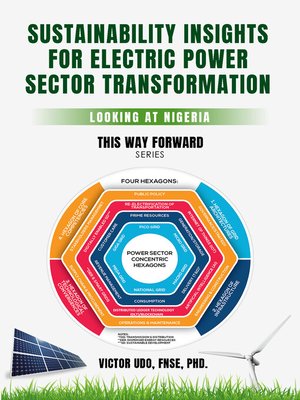Sustainability Insights For Electric Power Sector Transformation: Looking at Nigeria
ebook
By Victor Udo

Sign up to save your library
With an OverDrive account, you can save your favorite libraries for at-a-glance information about availability. Find out more about OverDrive accounts.
Find this title in Libby, the library reading app by OverDrive.



Search for a digital library with this title
Title found at these libraries:
| Library Name | Distance |
|---|---|
| Loading... |
This book presents the electric power sector as the combination of Alternating Current (AC) and Direct Current (DC) systems into an infrastructural value chain managed by a value constellation of stakeholders. The demand for global sustainability and emerging technological convergences are synergizing to transform the sector towards decarbonization enabled by digitalization and decentralization.
Sustainability insights on the simultaneously evolutionary and revolutionary processes that are helping the electric power sector to improve is provided by using Nigeria as a metaphor of underperformance. Effective application of these insights will encourage a leapfrog into transformational service provisioning for customers and the public in general. Presently across the globe (in most modern societies), AC and DC generation and utilization/consumption of electricity occurs as large-scale integrated systems - known as the electric power infrastructure or grid.
Such large-scale grid infrastructure requires certain competencies to develop, implement and manage effectively. With new technologies and the increasing demand for sustainability, this mostly centralized grid approach is transitioning from the existing to an emerging architecture. Both the existing and the emerging grid architecture require core competency and human development. The electric power sector provides services from the local to global (villages, communities, localities, state/provinces, regions, nations and internationally) as an infrastructural value chain/constellation.
With appropriate leadership, these infrastructural value chain and constellation of stakeholder ensure customer satisfaction while enabling social sustainability, technological sustainability and environmental sustainability. Technology convergence is driving the transformation of the sector. The two domains that determine the success of functional electric power sectors are covered in the book. These are the infrastructural value chain and utility services competencies. Contemporarily, both domains are being transformed by synergistic impacts of technological convergence and the emerging hierarchical grid architecture.
The book summarizes these changes as four groups of concentric hexagons – grid architecture, infrastructure, technological convergence and core competencies. The first which is Hexagon of Grid Architecture includes Giga, Mega, National, Macro, Micro and Pico/Nano grids. Critical sub-systems in the sector are covered as the second Hexagon of Infrastructure including prime resources, generation/storage, deliver ((transmission/ distribution), utilization/consumption, revenue collection and customer care.
The third is Hexagon of Technological Convergences which include distributed energy resources (DER)/smart grids, re-electrification of transportation, internet of things (IoT), distributed ledger technology (DLT)/blockchain and digitally enabled sustainable development (DESD). Hexagon of Core Competencies is the fourth in the group and the most important aspect of the electric power sector. It has to do with people – human capital in critical areas including public policy, corporate governance, strategic management, engineering, design/construction, supply chain/procurements, stakeholders' relationships management, finance, accounting/administration and operations, scheduling/maintenance.







